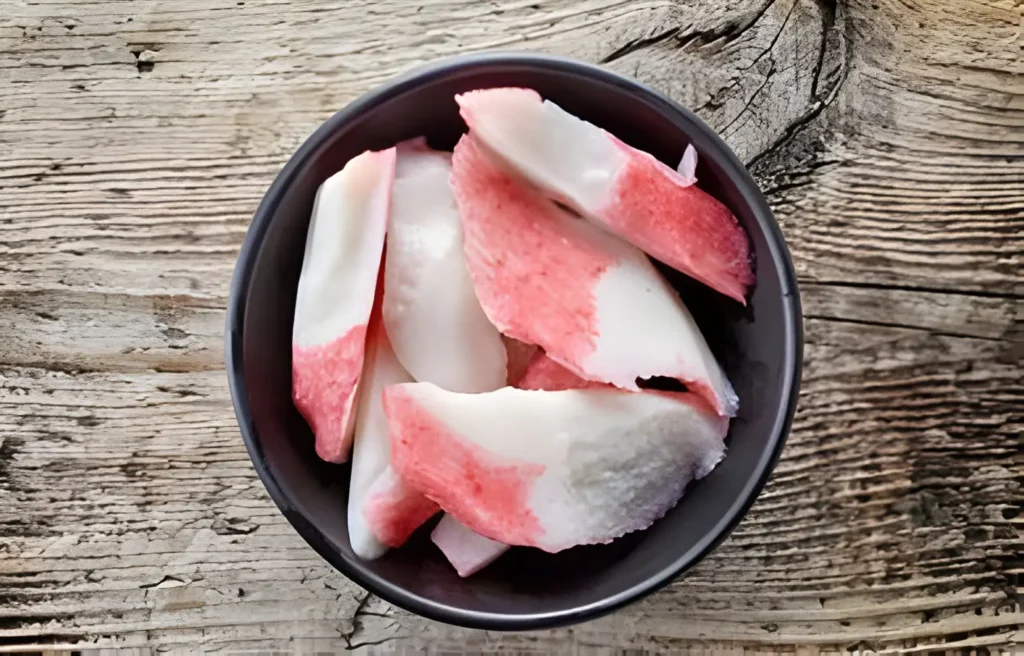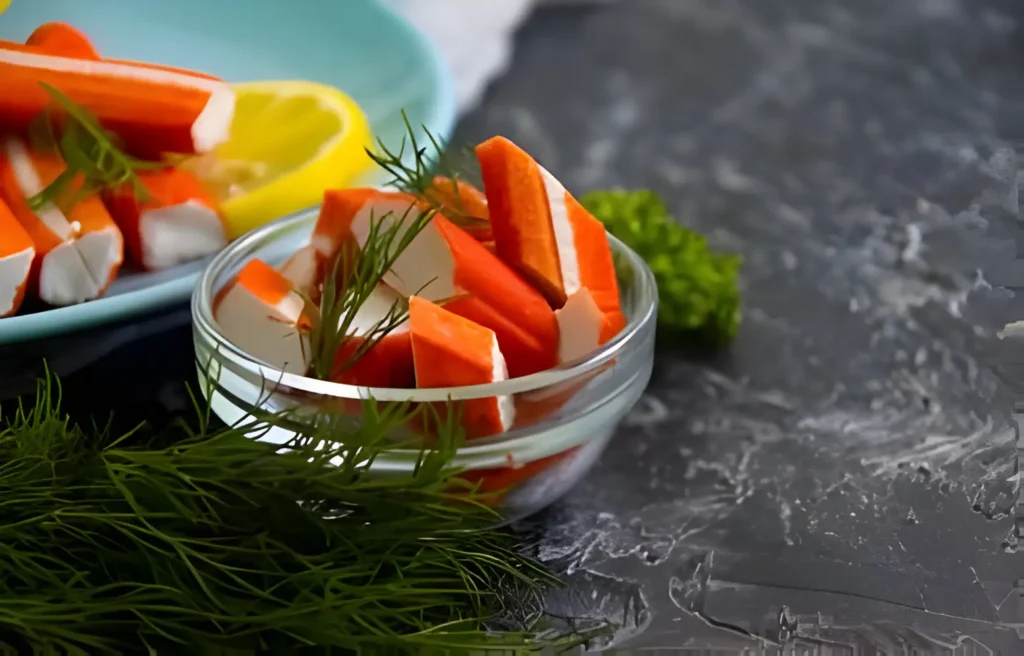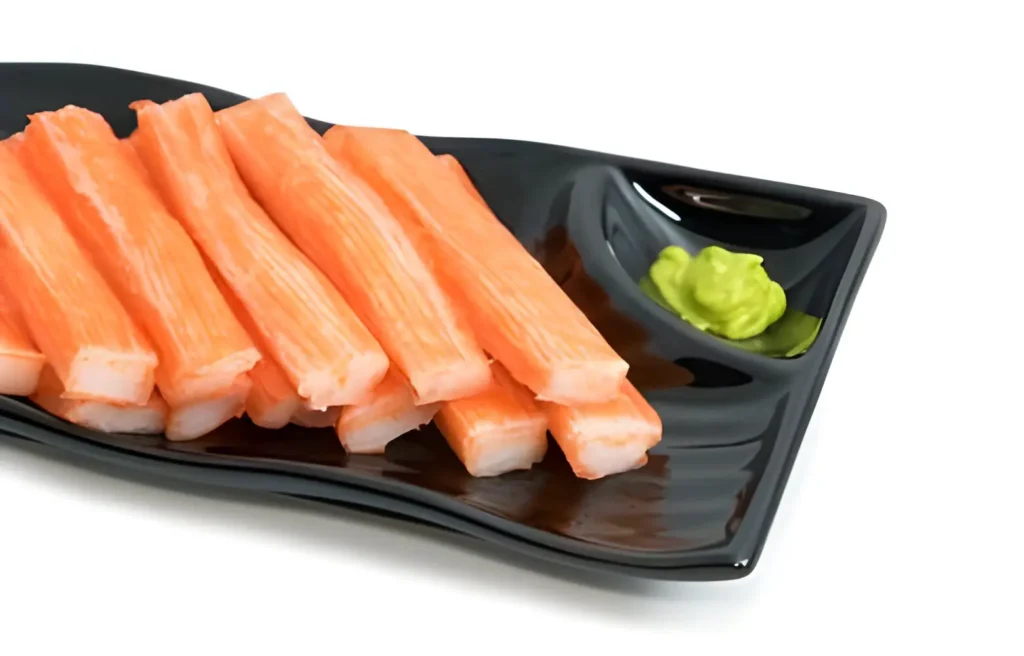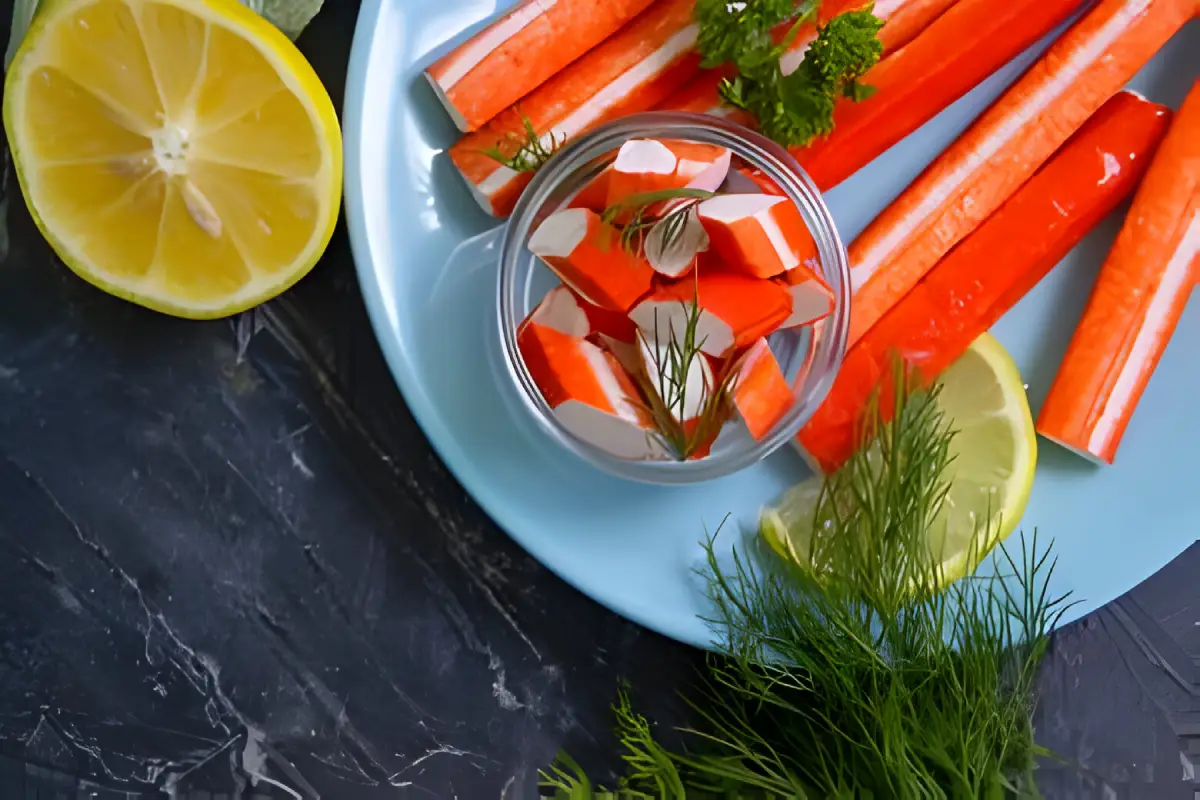In the bustling aisles of grocery stores and on the colorful plates of sushi restaurants, one ingredient that often captures the curiosity of food enthusiasts is imitation crab. Known for its versatility and affordability, imitation crab serves as a staple in various dishes worldwide. But what exactly is this popular seafood substitute, and more intriguingly, can you enjoy it raw straight from the package? This article dives into the heart of imitation crab, exploring its origins, nutritional content, and culinary applications, and addresses the common question: Can imitation crab be eaten raw? Join us on this culinary journey as we unravel the mysteries of imitation crab, offering insights, tips, and guidelines for safely incorporating this ingredient into your diet.
The Origins and Composition of Imitation Crab
Understanding Surimi
At the core of imitation crab is surimi, a Japanese term that translates to “ground meat.” Manufacturers make surimi by cleaning, mincing, and refining white-fleshed fish, such as pollock, to create a neutral-tasting base. This process has been part of Japanese cuisine for centuries, originally developed as a method to preserve surplus fish.
The Process of Making Imitation Crab
To transform surimi into the imitation crab we recognize, manufacturers add ingredients like starch, egg whites, and vegetable oil to improve its texture and stability. Manufacturers then introduce flavorings and colorings to mimic the taste and appearance of real crab meat. They cook the mixture and shape it into forms such as sticks or chunks.
Imitation crab emerged as a cost-effective alternative to expensive seafood, allowing broader access to crab-like flavors without the steep price tag. Its invention has not only democratized the consumption of seafood flavors but also sparked culinary creativity, leading to the creation of diverse recipes that cater to various tastes and dietary needs.
Understanding the careful blend of tradition and innovation that gives rise to imitation crab sets the stage for exploring its nutritional profile and how it fits into a healthy diet. Stay tuned as we delve deeper into the components that make imitation crab both a versatile and contentious ingredient in contemporary cuisine.
Nutritional Profile of Imitation Crab

While imitation crab has earned a spot in the hearts of seafood lovers and budget-conscious cooks alike, its nutritional value is often a topic of interest and sometimes, debate. Understanding what goes into this seafood substitute can help consumers make informed dietary choices.
Analyzing the Nutritional Content
At first glance, imitation crab seems like a health-conscious choice—it’s low in calories and fat while offering a moderate amount of protein. This makes it an attractive option for those looking to maintain a balanced diet without overindulging in calories. However, diving deeper into its nutritional makeup reveals aspects that warrant a closer look.
Health Benefits
Imitation crab provides essential nutrients including phosphorus, selenium, and some B vitamins, contributing to bone health, antioxidant defenses, and energy metabolism. Its main ingredient, surimi, is a good source of high-quality, lean protein, essential for muscle repair and growth.
Considerations and Allergies
However, it’s not all smooth sailing. One of the primary concerns with imitation crab is its sodium content. High in salt, it can contribute to increased blood pressure and cardiovascular risk, making it less ideal for those monitoring their sodium intake. Additionally, the product often contains gluten (from wheat starch) and added sugars, which may not suit individuals with gluten sensitivities, celiac disease, or those watching their sugar consumption.
Furthermore, because imitation crab may contain small amounts of real crab extract for flavoring, individuals with shellfish allergies should exercise caution. Always check labels for potential allergens to avoid adverse reactions.
Incorporating Imitation Crab into a Balanced Diet
While imitation crab can be part of a balanced diet, it should be consumed in moderation, especially by those with specific dietary concerns. Pairing it with whole, nutrient-rich foods like vegetables, whole grains, and healthy fats can enhance the nutritional value of meals featuring imitation crab, ensuring a well-rounded diet.
In the realm of culinary creativity, imitation crab stands out for its versatility and convenience. However, its nutritional profile reminds us of the importance of mindful consumption and the need to balance indulgence with health considerations. As we explore its various culinary uses and how it can be safely enjoyed—raw or cooked—we’re reminded of the endless possibilities this ingredient brings to the table and the importance of making choices that align with our health goals and dietary needs.
Stay tuned as we delve into the heart of culinary creativity with imitation crab, exploring its traditional uses and how it has inspired chefs and home cooks around the world.
Culinary Uses of Imitation Crab

Imitation crab shines in a variety of dishes, demonstrating its ability to complement different flavors and textures. Its application in both traditional and contemporary cuisine underscores its adaptability and widespread appeal.
Versatile Applications in Cooking
Sushi and Seafood Dishes
Perhaps most recognized for its role in California rolls, imitation crab is a sushi staple. Its texture and flavor make it an accessible option for homemade sushi, offering a seafood taste without the complexity of handling raw fish. Beyond sushi, imitation crab enhances seafood casseroles, crab dips, and seafood salads, adding depth and a hint of the ocean to every bite.
Salads and Appetizers
Imitation crab lends itself well to cold dishes, where you can appreciate its delicate flavor without the interference of strong cooking spices. Crab salad, for instance, combines imitation crab with fresh veggies, mayonnaise, and a touch of lemon for a refreshing meal or side dish. Similarly, imitation crab appetizers, like crab meat canapés or crab salad stuffed avocados, offer a light yet satisfying start to any dining experience.
Pasta and Rice Dishes
The mild taste of imitation crab pairs wonderfully with pasta and rice, providing a seafood-like essence without overpowering the dish. From creamy alfredo to zesty tomato-based sauces, imitation crab works well in a variety of pasta dishes. In rice dishes, it can be the protein in a hearty paella or a simple stir-fry, offering a quick and easy way to incorporate seafood flavors.
Soups and Stews
Imitation crab adds body and flavor to soups and stews, especially those with a seafood or Asian theme. It can be a cost-effective substitute in dishes that traditionally use more expensive seafood, such as cioppino or seafood gumbo, allowing for a similar taste profile at a fraction of the cost.
Best Practices for Cooking with Imitation Crab
When incorporating imitation crab into your cooking, remember that it is already cooked. This means you should add it towards the end of the cooking process to warm through, preventing it from becoming tough or rubbery. Its pre-cooked nature makes it an excellent choice for quick and easy meals, ensuring delicious results even on the busiest of days.
The culinary journey of imitation crab from a simple sushi ingredient to a versatile component in numerous dishes highlights its enduring popularity and adaptability. As we continue to explore the safety of consuming imitation crab raw, the conversation around this fascinating ingredient expands, reflecting its role in modern culinary practices and dietary habits.
Explore the National Fisheries Institute’s page for a deeper understanding of the culinary versatility of imitation crab and its role in a balanced diet.”
The Safety of Eating Imitation Crab Raw

A common question that surfaces when discussing imitation crab is its safety for consumption without cooking. Understanding the nuances of how imitation crab can be safely consumed is crucial for both culinary professionals and enthusiasts, given its processed nature and widespread use in various dishes.
Can Imitation Crab Be Eaten Raw?
The straightforward answer is yes, imitation crab can be eaten “raw” straight out of the package because it is not raw at all but rather fully cooked during the manufacturing process. This pre-cooked status makes it a convenient, ready-to-eat seafood option that can be safely incorporated into dishes without the need for additional cooking.
Understanding the Precooked Nature of Imitation Crab
Manufacturers make raw imitation crab from surimi, a paste of finely minced fish that they cook and flavor to mimic the taste and texture of crab meat. This process includes significant heat treatment, effectively eliminating any pathogens that may be present, rendering the product safe to consume directly from the package.
Safety Guidelines and Recommendations
While imitation crab is technically safe to eat without further cooking, there are still best practices to follow to ensure its quality and safety:
- Storage: Keep imitation crab refrigerated until ready to use. If you purchase the product frozen, thaw it in the refrigerator and consume it within two to three days.
- Packaging Integrity: Before consumption, check the packaging for any signs of damage or tampering. Compromised packaging can lead to contamination.
- Expiration Dates: Always observe the product’s expiration date. Do not consume imitation crab that has surpassed its recommended consumption date, as this increases the risk of foodborne illness.
The CDC offers comprehensive advice on the safety of consuming seafood products, including imitation crab.
Incorporating Imitation Crab into Your Diet
Given its safe, precooked nature, imitation crab is an excellent ingredient for quick and easy meals. You can add it to cold salads, sushi rolls, wraps, and other dishes where cooking is not feasible or desired. However, for those with specific dietary restrictions or allergies, particularly to fish, gluten, or certain additives, it’s essential to read the ingredient labels carefully.
The convenience and safety of eating imitation crab without further cooking make it a versatile ingredient in both planned meals and impromptu culinary creations. Its ability to bridge the gap between ease and flavor continues to endear it to a wide audience, from busy home cooks to creative chefs looking for an accessible seafood option.
As we transition to addressing frequently asked questions, our exploration into the world of imitation crab not only uncovers practical insights but also invites us to rethink our perceptions of this unique seafood substitute.
Frequently Asked Questions
- How long does raw imitation crab last in the fridge?
Once you open it, store imitation crab meat in the refrigerator and use it within 2-3 days for optimal freshness and safety. Unopened packages can last in the fridge until the date indicated on the packaging. - Is imitation crab suitable for people with seafood allergies?
While imitation crab is made from fish (usually pollock), it may contain traces of shellfish or other allergens used to enhance flavor. Individuals with seafood allergies should carefully read labels and may want to avoid imitation crab to prevent allergic reactions. - Can I freeze imitation crab?
Yes, you can freeze imitation crab, although this may affect its texture. To freeze, wrap it tightly in plastic wrap or place it in a freezer bag, trying to remove as much air as possible. It’s best to use it within 2-3 months. - Is imitation crab a healthy choice?
Imitation crab can be part of a healthy diet when consumed in moderation. It’s low in calories and provides some protein, but it’s also high in sodium and contains additives and gluten, which might not suit all dietary preferences. - Can I use imitation crab in hot dishes?
Absolutely! Although imitation crab is precooked and can be eaten straight from the package, it can also be warmed and added to various hot dishes like soups, stir-fries, and casseroles towards the end of the cooking process to prevent it from becoming too tough. - Does imitation crab taste like real crab?
Imitation crab is designed to mimic the flavor and texture of real crab meat, but discerning palates may notice differences. While it provides a similar seafood essence, the taste, texture, and quality can vary from real crab.
Conclusion
As we conclude our exploration into the world of imitation crab, we’ve traversed from its origins and composition to its nutritional implications, culinary versatility, and finally addressed the common inquiries surrounding its consumption. This journey reveals that imitation crab is more than just a substitute for real crab meat; it’s a testament to culinary innovation, offering a unique blend of convenience, flavor, and versatility that has secured its place in both traditional and modern dishes across the globe.
Imitation crab, with its ready-to-eat nature and ability to be incorporated into a vast array of recipes, from cold salads to warm, comforting soups, underscores the importance of understanding our food choices. It serves as a bridge between the desire for seafood flavors and the necessity for accessible, budget-friendly options. While it may not fully replicate the taste and texture of genuine crab meat, we cannot understate its role in promoting seafood experiences to a wider audience.
Moreover, the discussions around the nutritional content and safety of imitation crab highlight a broader conversation about mindful eating. They remind us of the importance of balancing convenience with health considerations, encouraging us to read labels carefully and consider dietary needs and restrictions in our culinary adventures.
Thank you for joining us on this deep dive into the intriguing world of imitation crab. May your culinary explorations be fruitful, your dishes flavorful, and your appetite for trying new ingredients never-ending. Here’s to the joy of cooking and the endless discovery it brings to our tables and taste buds.

